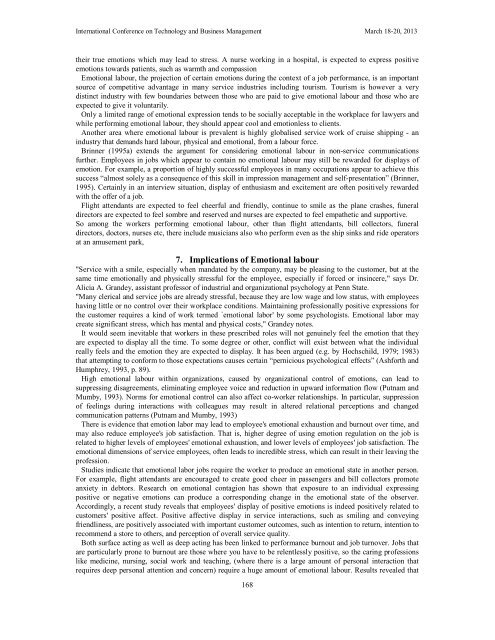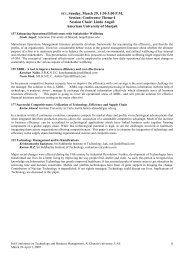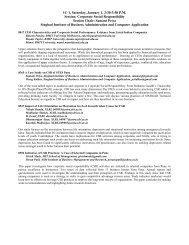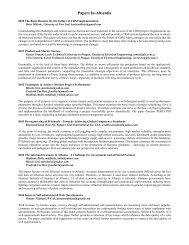Enormity of Emotional Labour and its Significance in the ... - Icmis.net
Enormity of Emotional Labour and its Significance in the ... - Icmis.net
Enormity of Emotional Labour and its Significance in the ... - Icmis.net
Create successful ePaper yourself
Turn your PDF publications into a flip-book with our unique Google optimized e-Paper software.
International Conference on Technology <strong>and</strong> Bus<strong>in</strong>ess Management March 18-20, 2013<br />
<strong>the</strong>ir true emotions which may lead to stress. A nurse work<strong>in</strong>g <strong>in</strong> a hospital, is expected to express positive<br />
emotions towards patients, such as warmth <strong>and</strong> compassion<br />
<strong>Emotional</strong> labour, <strong>the</strong> projection <strong>of</strong> certa<strong>in</strong> emotions dur<strong>in</strong>g <strong>the</strong> context <strong>of</strong> a job performance, is an important<br />
source <strong>of</strong> competitive advantage <strong>in</strong> many service <strong>in</strong>dustries <strong>in</strong>clud<strong>in</strong>g tourism. Tourism is however a very<br />
dist<strong>in</strong>ct <strong>in</strong>dustry with few boundaries between those who are paid to give emotional labour <strong>and</strong> those who are<br />
expected to give it voluntarily.<br />
Only a limited range <strong>of</strong> emotional expression tends to be socially acceptable <strong>in</strong> <strong>the</strong> workplace for lawyers <strong>and</strong><br />
while perform<strong>in</strong>g emotional labour, <strong>the</strong>y should appear cool <strong>and</strong> emotionless to clients.<br />
Ano<strong>the</strong>r area where emotional labour is prevalent is highly globalised service work <strong>of</strong> cruise shipp<strong>in</strong>g - an<br />
<strong>in</strong>dustry that dem<strong>and</strong>s hard labour, physical <strong>and</strong> emotional, from a labour force.<br />
Br<strong>in</strong>ner (1995a) extends <strong>the</strong> argument for consider<strong>in</strong>g emotional labour <strong>in</strong> non-service communications<br />
fur<strong>the</strong>r. Employees <strong>in</strong> jobs which appear to conta<strong>in</strong> no emotional labour may still be rewarded for displays <strong>of</strong><br />
emotion. For example, a proportion <strong>of</strong> highly successful employees <strong>in</strong> many occupations appear to achieve this<br />
success “almost solely as a consequence <strong>of</strong> this skill <strong>in</strong> impression management <strong>and</strong> self-presentation” (Br<strong>in</strong>ner,<br />
1995). Certa<strong>in</strong>ly <strong>in</strong> an <strong>in</strong>terview situation, display <strong>of</strong> enthusiasm <strong>and</strong> excitement are <strong>of</strong>ten positively rewarded<br />
with <strong>the</strong> <strong>of</strong>fer <strong>of</strong> a job.<br />
Flight attendants are expected to feel cheerful <strong>and</strong> friendly, cont<strong>in</strong>ue to smile as <strong>the</strong> plane crashes, funeral<br />
directors are expected to feel sombre <strong>and</strong> reserved <strong>and</strong> nurses are expected to feel empa<strong>the</strong>tic <strong>and</strong> supportive.<br />
So among <strong>the</strong> workers perform<strong>in</strong>g emotional labour, o<strong>the</strong>r than flight attendants, bill collectors, funeral<br />
directors, doctors, nurses etc, <strong>the</strong>re <strong>in</strong>clude musicians also who perform even as <strong>the</strong> ship s<strong>in</strong>ks <strong>and</strong> ride operators<br />
at an amusement park,<br />
7. Implications <strong>of</strong> <strong>Emotional</strong> labour<br />
"Service with a smile, especially when m<strong>and</strong>ated by <strong>the</strong> company, may be pleas<strong>in</strong>g to <strong>the</strong> customer, but at <strong>the</strong><br />
same time emotionally <strong>and</strong> physically stressful for <strong>the</strong> employee, especially if forced or <strong>in</strong>s<strong>in</strong>cere," says Dr.<br />
Alicia A. Gr<strong>and</strong>ey, assistant pr<strong>of</strong>essor <strong>of</strong> <strong>in</strong>dustrial <strong>and</strong> organizational psychology at Penn State.<br />
"Many clerical <strong>and</strong> service jobs are already stressful, because <strong>the</strong>y are low wage <strong>and</strong> low status, with employees<br />
hav<strong>in</strong>g little or no control over <strong>the</strong>ir workplace conditions. Ma<strong>in</strong>ta<strong>in</strong><strong>in</strong>g pr<strong>of</strong>essionally positive expressions for<br />
<strong>the</strong> customer requires a k<strong>in</strong>d <strong>of</strong> work termed `emotional labor' by some psychologists. <strong>Emotional</strong> labor may<br />
create significant stress, which has mental <strong>and</strong> physical costs," Gr<strong>and</strong>ey notes.<br />
It would seem <strong>in</strong>evitable that workers <strong>in</strong> <strong>the</strong>se prescribed roles will not genu<strong>in</strong>ely feel <strong>the</strong> emotion that <strong>the</strong>y<br />
are expected to display all <strong>the</strong> time. To some degree or o<strong>the</strong>r, conflict will exist between what <strong>the</strong> <strong>in</strong>dividual<br />
really feels <strong>and</strong> <strong>the</strong> emotion <strong>the</strong>y are expected to display. It has been argued (e.g. by Hochschild, 1979; 1983)<br />
that attempt<strong>in</strong>g to conform to those expectations causes certa<strong>in</strong> “pernicious psychological effects” (Ashforth <strong>and</strong><br />
Humphrey, 1993, p. 89).<br />
High emotional labour with<strong>in</strong> organizations, caused by organizational control <strong>of</strong> emotions, can lead to<br />
suppress<strong>in</strong>g disagreements, elim<strong>in</strong>at<strong>in</strong>g employee voice <strong>and</strong> reduction <strong>in</strong> upward <strong>in</strong>formation flow (Putnam <strong>and</strong><br />
Mumby, 1993). Norms for emotional control can also affect co-worker relationships. In particular, suppression<br />
<strong>of</strong> feel<strong>in</strong>gs dur<strong>in</strong>g <strong>in</strong>teractions with colleagues may result <strong>in</strong> altered relational perceptions <strong>and</strong> changed<br />
communication patterns (Putnam <strong>and</strong> Mumby, 1993)<br />
There is evidence that emotion labor may lead to employee's emotional exhaustion <strong>and</strong> burnout over time, <strong>and</strong><br />
may also reduce employee's job satisfaction. That is, higher degree <strong>of</strong> us<strong>in</strong>g emotion regulation on <strong>the</strong> job is<br />
related to higher levels <strong>of</strong> employees' emotional exhaustion, <strong>and</strong> lower levels <strong>of</strong> employees' job satisfaction. The<br />
emotional dimensions <strong>of</strong> service employees, <strong>of</strong>ten leads to <strong>in</strong>credible stress, which can result <strong>in</strong> <strong>the</strong>ir leav<strong>in</strong>g <strong>the</strong><br />
pr<strong>of</strong>ession.<br />
Studies <strong>in</strong>dicate that emotional labor jobs require <strong>the</strong> worker to produce an emotional state <strong>in</strong> ano<strong>the</strong>r person.<br />
For example, flight attendants are encouraged to create good cheer <strong>in</strong> passengers <strong>and</strong> bill collectors promote<br />
anxiety <strong>in</strong> debtors. Research on emotional contagion has shown that exposure to an <strong>in</strong>dividual express<strong>in</strong>g<br />
positive or negative emotions can produce a correspond<strong>in</strong>g change <strong>in</strong> <strong>the</strong> emotional state <strong>of</strong> <strong>the</strong> observer.<br />
Accord<strong>in</strong>gly, a recent study reveals that employees' display <strong>of</strong> positive emotions is <strong>in</strong>deed positively related to<br />
customers' positive affect. Positive affective display <strong>in</strong> service <strong>in</strong>teractions, such as smil<strong>in</strong>g <strong>and</strong> convey<strong>in</strong>g<br />
friendl<strong>in</strong>ess, are positively associated with important customer outcomes, such as <strong>in</strong>tention to return, <strong>in</strong>tention to<br />
recommend a store to o<strong>the</strong>rs, <strong>and</strong> perception <strong>of</strong> overall service quality.<br />
Both surface act<strong>in</strong>g as well as deep act<strong>in</strong>g has been l<strong>in</strong>ked to performance burnout <strong>and</strong> job turnover. Jobs that<br />
are particularly prone to burnout are those where you have to be relentlessly positive, so <strong>the</strong> car<strong>in</strong>g pr<strong>of</strong>essions<br />
like medic<strong>in</strong>e, nurs<strong>in</strong>g, social work <strong>and</strong> teach<strong>in</strong>g, (where <strong>the</strong>re is a large amount <strong>of</strong> personal <strong>in</strong>teraction that<br />
requires deep personal attention <strong>and</strong> concern) require a huge amount <strong>of</strong> emotional labour. Results revealed that<br />
168







